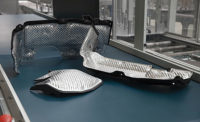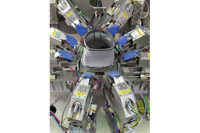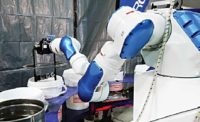Not every technological advancement in automotive assembly gets adequate recognition. Consider, for example, how much has been written about the use of aluminum in the redesigned 2019 Dodge RAM 1500 and 2500 trucks, vs. that of ultrasonic welding.
In 2018, Telsonic Ultrasonics Inc. provided Grupo Antolin with several vibration welders and hundreds of horns, punch and anvil sets, actuators, MAG generators and converters to weld numerous sections of the truck at the company’s plant in Shelby Township, MI. These include door panels, bumper trims, instrument panels and headliners (material adhered to the inside roof).
Two 740e welders produce hood vents and body caps, while a 730e vibration welder creates glove boxes and knee protectors. Separately, a 930e welder produces the passenger air bag chute.
Increased use of ultrasonic welding by automakers outside the U.S. is also overlooked. Case in point: Telsonic AG’s Moscow-based distributor Windeq TC is the first Russian company to design and produce semiautomatic ultrasonic systems for automotive manufacturers there. One is Magna Automotive RUS, which makes a wide range of parts for assembly and has used ultrasonic welding since 2019.
The company welds several components for Volkswagen’s Škoda Karoq, Škoda Rapid and VW 316 Tarek vehicles. Magna does likewise for the AutoVAZ Lada models. Sensor brackets are mounted on the Škoda’s thin-walled front bumpers using Telsonic ultrasonic welding equipment. Front and rear spoilers, as well as mountings for reflectors, are welded components on the Tarek.
As for the Lada cars, welding systems attach the balcony structures that guide electric window regulators and the brackets that hold storage compartments to the interior door panels. Galina Steffen, sales engineer at Telsonic AG, says that Magna chose dual sonotrodes for these applications because welding is performed at particular spots and along seams that are close together.
A dual sonotrode provides a huge advantage here, according to Steffen, because it simultaneously produces two welding points, but requires only one converter and booster to apply mechanical vibrations. In addition, any common fieldbus interface can be used to enable the system’s ultrasonic generators to communicate with the control system of the plastics processing machine.
Since working with Grupo Antolin a couple years ago, Telsonic has updated its welding system offerings. The company’s current torsional welding series lineup includes the MPX HD and MT8000 for metal welding. Linear (USP), torsional (TSP) and metal welding (MPX Ultrasonics) presses are available, as well. Also sold are a handheld weld unit, called the Handystar, and the AC actuator series for production lines.
The MAG generator provides constant power and amplitude across the entire voltage range from 180 to 260 volts. It also offers high process repeat accuracy, maximum cycle rates through dynamic control and state-of-the-art fieldbus interfaces. Its space-saving design is optimized for a 300-millimeter-deep switch cabinet.
Located in Bronschhofen, Switzerland, the Telsonic Group has been offering its industrial ultrasonic welders in Europe, America and Asia since 1966. It specializes in plastic and metal welding, as well as ultrasonic cleaning and screening. Worldwide, the company serves customers in automotive, packaging and medical technology.
For more information on ultrasonic welding, call 617-244-0400 or visit www.telsonic.com.





